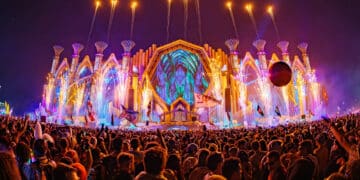The evolution of dance music continues to push boundaries while also paying homage to its own roots in classical music.
Years ago, I grew up with a stigma against the music I loved. Dance music, growing in its initial popularity in the late 1990s and early 2000s, swept into the new millennium as so many other things did – on the back of a digital revolution, thanks to computer technologies continued falling price-point and the rapid growth of the internet. As such, it was labelled, in those rising years, as simple “computer music.” Countless conversations permeated my ears of how it was not “music,” how bands and pop acts were better because it was “performed live with instruments,” or how it was all just “bleeps and boops and robotic noise.”
Forget the fact that digital recording and the CD had become mainstays of the musician’s process in the 1980s. Forget the fact that live performance was taken over by the electronic piano, the synthesizer, and the digital effects panels that warped sound in real time on stage by musicians. These elements avoided the stigma, yet it continued to choke dance music. As songs like Darude’s “Sandstorm,” Alice Deejay’s “Better Off Alone,” Fatboy Slim’s “Praise You,” Real McCoy’s “Another Night,” Haddaway’s “What Is Love,” Eiffel 65’s “Blue,” and Daft Punk’s numerous hits took the over radio airplay spots, the arguments about this new style of “music” lacking “musicality” continued to gain strength.
Fast forward to the modern soundscape where electronic dance music took not just airwaves around the world, but also took over the means of music production, pioneered the move from clubs to massive festivals around the globe, and turned DJs into “rock-stars” (what else would you call the likes of Armin van Buuren, Tiesto, and their kinsman at this point?). In the present, no one laughs off the impact electronic dance music has pressed upon the music. No one doubts its credentials anymore… or do they? Undoubtedly, electronic music still has its detractors. What case could we lay before those individuals?
After pondering this for years, I finally feel I have enough evidence to really showcase how beautiful and musical dance music is.
First, we have the albums that expand dance music beyond the computer realm.
The easiest example showcasing how the arrangements that electronic music producers use catalyze musical heritage over the centuries is in the recent trend rearranging our collective dance music heritage into classical albums built for both small and large orchestras. Most famously, Pete Tong teamed up with The Heritage Orchestra and jump-started the current trend of classical reworks.
Now three albums deep, their collaborations (2016’s Classic House, 2017’s Ibiza Classics, and 2019’s Chilled Classics) capture the zeitgeist of dance music’s seminal tracks and offer arrangements that release a breadth of emotions the original tracks emanate. When I asked our founder and CEO for a track to showcase this, his selection represents instant gold: “You Got The Love.” I’ll let the beauty speak for itself.
Taking things beyond Pete Tong’s contributions, there are other conductors creating rearrangements of classic tracks.
I stumbled across the amazing rearrangements of hits from the 1990s thanks to Alex Christensen & The Berlin Orchestra earlier this year. Now on a third volume as well, each volume of Classical ’90s collects a variety of songs and styles that all were hits on the dance floor or in the pop circuit during the 1990s.
The arrangements here are stunning – speaking to how tracks such as Eiffel 65’s “Blue,” while simple in construction, still retain the beauty of moving melodies and energetic rhythms. You hear how covers of Real McCoy’s “Another Night,” Darude’s “Sandstorm,” and even Aqualung’s “Barbie Girl” all exude not only the hooks that made them famous but how they encapsulate the musicality that shaped the landscape towards the 2010 music revolution.
If you need more evidence, just listen below to how they rearranged the classic “Rhythm of the Night” from Alex Christensen & The Berlin Orchestra featuring Yaas.
Let’s pivot the facet into a different realm that still proves the influence of classical styles on the genre.
There is an interesting story behind the artistic endeavor of BT’s Electronic Opus. The interesting take on BT’s catalog of productions did not strip away the dance roots – the furious energy of four-to-the-floor beats remains – nor did it relinquish the synthesized melodies. However, it does provide plenty to love and still showcases the musical bliss of dance music.
BT performed this album a few years ago during the Miami Music Week, with the orchestra backing up all the electronic elements and vocalists he could bring. While the project had some very public issues relating to its Kick-starter campaign and partnerships, it did not detract from the beauty of the rearrangements crafted by the hands of BT and Tommy Tallarico, known for the Video Games Live projects. Just listen to the stunning atmosphere their reworking of “Satellite” provides: sweeping strings, pointed percussion, and cohesion above all else.
Second, there are artists transcending into full bands or collaborating with orchestras directly in live atmospheres!
Classical influences on dance music continues as producers now flip the scripts by switching into live bands for performances around the world. This is either combining forces with a number of musicians for a unique artistic performance or pulling in a full orchestra to work with. As such, let’s examine some of the coolest performances to date.
Flight Facilities performance with the Melbourne Symphony Orchestra was truly remarkable.
Conducted as part of the Annual China Southern Airlines Concert at the Melbourne Festival 2015, Flight Facilities joined forces with the Melbourne Symphony Orchestra for a performance that captivates the ears. Greeted by the warmth of strings and the boom of the brass, the symphony and producers explore the catalog of Flight Facilities’ music. There’s a bit of funk, a strong cadre of vocalists, and a melding of the minds that provides such blissful emotions straight from the performance.
The playlist shuffles between original works and remixes of the duo and highlights the intrinsic musicality of their productions. Swelling overtures take on the inherent dance floor moods of their productions. Note, however, the performance does not abandon the beats of their tracks. For example, “Waking Bliss” features a groovy bassline and the beats of a drum machine with the sampled vocals and vocals from Owl Eyes. The flight is ready to take you on a journey!
The next example brings a whole new mood thanks to Camo & Krooked and the Red Bull Symphonic!
In evidence number two, we tackle the same style of performance in a new genre. Landing during the global shutdown because of the COVID-19 pandemic, Camo & Krooked teamed up with the Red Bull Symphonic right before doors around the world shuttered for a unique performance of their music. Delivered in album format, those of us who missed out during the Vienna performance get to enjoy it in full.
As part of my personnel rotation for the last few months, the performance and album shine with the unique arrangements of Camo & Krooked’s signature style. The crowd’s enthusiasm and energy exemplify how the music infuses into one’s self. Just watch “Witch Doctor” below; it just exudes the energy of the drum & bass duo while providing an amazing foundation to display how the music retains the motifs of classical music.
Keeping on the drum and bass tip, but showcasing the band side of things is London Elektricity Big Band.
After years of shelving the creative band concept, Tony Coleman, better known as London Elektricity, decided to enjoy the big band experience. In 2017, the band put out two live albums (Live In The Park and Live at Pohoda) bridging drum and bass with the sounds of jazz. The mood is celebratory – focused on how music captures both moods and movements. If you need evidence, just watch the energy and passion on display in “Remember The Future” performed during the Hospitality In The Park 2016 below.
Further capturing the imagination are Above & Beyond’s Acoustic performances!
It would not be fair to discuss the “return to band” form of dance music without showcasing the amazing work Above & Beyond repeatedly executed since introducing their acoustic style. The release of “Live at the Hollywood Bowl” from their Acoustic II tour empowers how the music we love has expanded its horizons beyond “computer music.”
Mixing the beauty of brass, strings, the piano, guitars, and more, Above & Beyond’s perfects the mix of live performance and artistry in their acoustic shows. If you somehow missed out on watching this performance, check it out in full below thanks to YouTube.
Finally, there are beautiful performances that showcase the genre’s roots!
As the above examples show, the varied nature and interpretations of dance music display its integrated musicality. The power of this musical passion we share knows no limits, and collectively it builds on all that came before. Certainly, the performances of symphonies and bands above show the beauty of this musical gathering. Yet, some may retain hesitation – after all, most of what lays here are works and retooling of songs written by dance music’s elites. How hard is it for them to adapt the bodies of work they are most familiar with?
In the spirit of showing how beautiful the music is, let us examine the final round of exhibits. Performance is the greatest brush for many when understanding music, and it may not be expressed well by the art of the DJ on massive festival stages around the world. So, instead, let us embark on a voyage through sound to explore unique performances that display the broader reach of dance music’s bliss.
Case number one, the unique element of Tomorrowland’s “Symphony of Unity.”
The symphony’s performance re-imagined major songs throughout the years – everything from Robert Miles “Children” to Fisher’s “Losing It.” The symphony, particularly the Tomorrowland 2019 version, captivated the dance music fans from around the world. It was not simply nostalgia at play here; it was the deep and powerful response that people love hearing in dance music. Just read this comment left by Miguel Hernández on YouTube, “We were at 40 degrees, we were in the rain, we missed [the] Freedom stage. None of this mattered. When the first Opus notes sounded, everything made sense. It was something beyond music. We need more of this magic.” ‘Nuff said!
The second case: The Radio 1 Proms – Ibiza style!
When Pete Tong first introduced the Classic House concept, it felt full of risk to the worldwide market. Would the fans of raves follow the music into a proper concert setting with an orchestra? Enter the precursor event: 2015’s Radio 1 Ibiza Prom – a showcase of house music performed during the annual Proms at the Royal Albert Hall in London.
The Proms, short for promenade concerts, feature eight weeks of daily classical concerts where guests enjoy a variety of performances in all styles. After 120 years, the Proms received their first tribute to the almighty worldwide dance machine. This remains one of the most captivating performances of dance music’s hits from the twenty years prior to the performance, and if you never experienced it before, set aside some time to enjoy it.
The third is when one wants to celebrate 40 years of history while saying farewell, enter Hardwell’s “Global Revolution Of Dance.”
This brings us to the final concert to discuss, one that represents the end of one segment of an artist’s career. The Metropole Orkest, the orchestra behind Tomorrowland’s “Symphony of Unity” joined with Hardwell to explore the history of dance music. The performance, titled “Symphony: The Global Revolution Of Dance” brought Hardwell as the DJ/MC of the event and captured music from the decades of electronic music from around the world.
Starting in 1978, they explore how pop and electronic music took the world by storm as time moves to the present. Mike Oldfield’s “Tubular Bells,” Donna Summer’s disco hit “I Feel Love,” and the Eurythmics’ “Sweet Dreams” kick it off in earnest. By the end, we journey all the way to Hardwell’s smash hit “Spaceman,” Dimitri Vegas & Like Mike’s collaboration with Martin Garrix in 2014’s “Tremor” and Armin van Buuren’s sing-a-long anthem with Trevor Guthrie “This Is What It Feels Like.”
Not only does this performance solidly showcase the musicality of dance music throughout its history, but it also provides a beautiful history lesson on the genre as a whole. Watch the entire performance with Amazon Prime below!
As we conclude, the case for the musicality of dance music is clear before us!
The evidence lays before you – denying the inherent musicality of dance music as a whole or dismissing it simply as “computer music” is a gross injustice to the decades of producers and acts that have made this far-reaching music.
The beauty of dance music – whether techno, trance, house, drum & bass, or hard dance – lies in its adaptation of the rules over the eons that governed music. While it has been heavily influenced by Western music motifs up to this point, the expanding markets of South America and Asia offer an expanded opportunity to adapt new rules from heritages and cultures unfamiliar to the genre yet.
If one wants to argue that the above examples are not contemporary enough, not immediate enough, find this package before them. There is a collective known as the Kaleidoscope Orchestra which covers all sorts of music – from dance music acts Daft Punk and Fatboy Slim to hip-hop acts like Childish Gambino and Eminem. Their most recent cover: Camelphat x ARTBAT’s “For a Feeling.” Just listen below and enjoy the journey.








